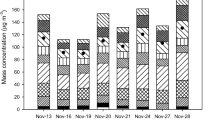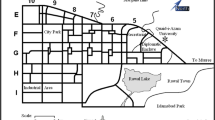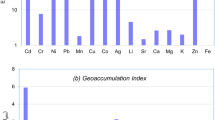Abstract
The effects of atmospheric pollution from ship emissions have been considered for several harbors worldwide. The health risk assessment and source apportionment of particle-bound metals in a fishery harbor were investigated in this study. The most abundant metal elements in particulate matter (PM) on all sampling days in three seasons were Fe (280.94 ± 136.93 ng/m3), Al (116.40 ± 71.25 ng/m3), and Zn (110.55 ± 26.70 ng/m3). The ratios of V/Ni were 1.44 ± 0.31, 1.48 ± 0.09 and 1.87 ± 0.06 in PM10, PM2.5, and PM1, respectively. Meanwhile, the ratios higher than 1 indicated that fuel oil combustion from ship emission in fishery harbor. The highest deposits of total particle-bound metals in the human respiratory tract were in the head airway (HA), accounting for 76.77 ± 2.29% of the total particle-bound metal concentration, followed by 5.32 ± 0.13% and 2.53 ± 0.15% in the alveolar region (AR) and tracheobronchial (TB) region, respectively. The total cancer risk (CR) of inhalation exposure to local residents exceeded 10−6. Mean total CR values followed the sequence: autumn (1.24 × 10−4) > winter (8.53 × 10−5) > spring (2.77 × 10−6). Source apportionment of related metal emissions was mobile pollution emissions (vehicle/boat) (37.10–48.92%), metal fumes of arc welding exhaust (19.68–34.42%), spray-painting process (12.34–16.24%), combustion emissions (6.32–13.12%), and metal machining processes (9.04–16.31%) in Singda fishing harbor. These results suggest that proper control of heavy metals from each potential source in fishing harbor areas should be carried out to reduce the carcinogenic risk of adverse health effects.




Similar content being viewed by others
Data Availability
The datasets generated and/or analyzed during the current study are not publicly available due [REASON WHY DATA ARE NOT PUBLIC] but are available from the corresponding author on reasonable request.
References
Alexandersson A, Flodström E, Staalberg P (1993) Exhaust gas emissions from sea transportation. TFB Rapport.
Amato F, Pandolfi M, Escrig A, Querol X, Alastuey A, Pey J, Pérez N, Hopke PK (2009) Quantifying road dust resuspension in urban environment by multilinear engine: a comparison with PMF2. Atmos Environ 43:2770–2780
Blifford IH, Meeker GO (1967) A factor analysis model of large scale pollution. Atmos Environ 1(2):147–157
Cena L, Chisholm W, Keane M, Chen B (2015) A field study on the respiratory deposition of the nano-sized fraction of mild and stainless steel welding fume metals. J Occup Environ Hyg 12:721–728
Chen K-F, Tsai Y-P, Lai C-H, Xiang Y-K, Chuang K-Y, Zhu Z-H (2021) Human health-risk assessment based on chronic exposure to the carbonyl compounds and metals emitted by burning incense at temples. Environ Sci Pollut R 28:40640–40652
Chen X, Ward TJ, Sarkar C, Ho KF, Webster C (2022) Health risks of adults in Hong Kong related to inhalation of particle-bound heavy metal (loid) s. Air Qual Atmos Hlth 15(4):691–706
Comero S, Capitani L, Gawlik BM (2009) Positive Matrix Factorisation (PMF). An introduction to the chemometric evaluation of environmental monitoring data using PMF, European commission joint research centre. Office for Official Publications of the European Communities, Luxembourg, p 58.
Corbett JJ, Winebrake JJ, Green EH, Kasibhatla P, Eyring V, Lauer A (2007) Mortality from ship emissions: a global assessment. Environ Sci Technol 41:8512–8518
Du B, Zhang H, Ji D, Huang Z, Fangqun G, Zhou J. (2022) Environmental contamination and health risk assessment to toxic elements in an active lead–zinc mining area. Expos Health, pp 1–12.
EPA US (U.S. Environmental Protection Agency), 2013. User's guide/technical background document for US EPA Region 9's RSL (regional screening levels) tables. http://www.epa.gov/region9/superfund/prg/ (2013)
Gao Y, Nelson E, Field M, Ding Q, Li H, Sherrell R, Gigliotti C, Van Ry D, Glenn T, Eisenreich S (2002) Characterization of atmospheric trace elements on PM2.5 particulate matter over the New York-New Jersey harbor estuary. Atmos Environ 36:1077–1086
Gianini MFD, Piot C, Herich H, Besombes JL, Jaffrezo JL, Hueglin C (2013) Source apportionment of PM10, organic carbon and elemental carbon at Swiss sites: an intercomparison of different approaches. Sci Total Environ 454:99–108
Gong H, Huang Y, Hu H, Fu B, Ma T, Li S, Xie K, Luo G, Yao H (2019) Insight of particulate arsenic removal from coal-fired power plants. Fuel 257:116018
Grashow R, Zhang J, Fang SC, Weisskopf MG, Christiani DC, Cavallari JM (2014) Toenail metal concentration as a biomarker of occupational welding fume exposure. J Occup Environ Hyg 11:397–405
Guo H, Wang T, Louie P (2004) Source apportionment of ambient non-methane hydrocarbons in Hong Kong: application of a principal component analysis/absolute principal component scores (PCA/APCS) receptor model. Environ Pollut 129:489–498
Harman HH, Harman HH (1976) Modern factor analysis. University of Chicago press, Ottawa
Huang Y, Hu H, Fu B, Zou C, Liu H, Liu X, Wang L, Luo G, Yao H (2022) Fine particulate-bound arsenic and selenium from coal-fired power plants: formation, removal and bioaccessibility. Sci Total Environ 823:153723
IARC: diesel engine exhaust carcinogenic (2012) (accessed 5.8.2023) https://www.iarc.who.int/news-events/iarc-diesel-engine-exhaust-carcinogenic/
IMO (2021). Fourth greenhouse gas study 2020. Published in 2021 by the international maritime organization 4 Albert Embankment, London SE1 7SR.
Isakson J, Persson T, Lindgren ES (2001) Identification and assessment of ship emissions and their effects in the harbour of Göteborg, Sweden. Atmos Environ 35:3659–3666
Jenkins N, Eagar T (2005) Chemical analysis of welding fume particles. Weld J NY 84:87
Jeong JH, Shon ZH, Kang M, Song SK, Kim YK, Park J, Kim H (2017) Comparison of source apportionment of PM2.5 using receptor models in the main hub port city of East Asia: Busan. Atmos Environ 148:115–127
Kumar A, Sarin MM (2009) Mineral aerosols from western India: temporal variability of coarse and fine atmospheric dust and elemental characteristics. Atmos Environ 43(26):4005–4013
Kumar A, Sarin MM (2010) Atmospheric water-soluble constituents in fine and coarse mode aerosols from high-altitude site in western India: long-range transport and seasonal variability. Atmos Environ 44(10):1245–1254
Lai C-H, Yan T-Y (2016) Characteristics and aerosol size distributions of metal-containing paint particles at a spray-painting workplace. RSC Adv 6:113754–113761
Lai C-H, Chuang K-Y, Chang J-W (2013) Source apportionment of volatile organic compounds at an international airport. Aerosol Air Qual Res 13:689–698
Lai C-H, Lin C-H, Liao C-C (2017) Respiratory deposition and health risk of inhalation of particle-bound heavy metals in the carbon black feeding area of a tire manufacturer. Air Qual Atmos Hlth 10:1281–1289
Li J, Wang G, Liu F, Cui L, Jiao Y (2021) Source apportionment and ecological-health risks assessment of heavy metals in topsoil near a factory, Central China. Expos Health 13:79–92
Lin C-C, Chen S-J, Huang K-L, Hwang W-I, Chang-Chien G-P, Lin W-Y (2005) Characteristics of metals in nano/ultrafine/fine/coarse particles collected beside a heavily trafficked road. Environ Sci Technol 39:8113–8122
Lin H, Tao J, Qian ZM, Ruan Z, Xu Y, Hang J, Xu X, Liu T, Guo Y, Zeng W (2018) Shipping pollution emission associated with increased cardiovascular mortality: a time series study in Guangzhou, China. Environ Pollut 241:862–868
Lin C-H, Lai C-H, Peng Y-P, Wu P-C, Chuang K-Y, Yen T-Y, Xiang Y-K (2019) Comparative health risk of inhaled exposure to organic solvents, toxic metals, and hexavalent chromium from the use of spray paints in Taiwan. Environ Sci Pollut R 26:33906–33916
Lin C-H, Lai C-H, Hsieh T-H, Tsai C-Y (2022) Source apportionment and health effects of particle-bound metals in PM2.5 near a precision metal machining factory. Air Qual Atmos Hlth 15:605–617
Liu X, Wang Z, Bai H, Zhang S, Mu L, Peng L (2020) Characteristics and health risk assessments of heavy metals in PM2.5 in Taiyuan and Yuci college town. China Air Qual Atmos Hlth 13:909–919
Liu H, Wang Y, Dong J, Cao L, Yu L, Xin J (2021) Distribution characteristics, pollution assessment, and source identification of heavy metals in soils around a landfill-farmland multisource hybrid district. Arch Environ Con Tox 81(1):77–90
Logiewa A, Miazgowicz A, Krennhuber K, Lanzerstorfer C (2020) Variation in the concentration of metals in road dust size fractions between 2 µm and 2 mm: results from three metallurgical centres in Poland. Arch Environ Con Tox 78:46–59
Lough GC, Schauer JJ, Park J-S, Shafer MM, DeMinter JT, Weinstein JP (2005) Emissions of metals associated with motor vehicle roadways. Environ Sci Technol 39:826–836
Mamoudou I, Zhang F, Chen Q, Wang P, Chen Y (2018) Characteristics of PM2.5 from ship emissions and their impacts on the ambient air: a case study in Yangshan Harbor, Shanghai. Sci Total Environ 640:207–216
Martínez Morales S, Cerón Bretón JG, Carbajal N. et al. (2023). PM2.5-bound trace metals in an urban area of Northern Mexico during the COVID-19 pandemic: characterization, sources, and health risk. Air Qual Atmos Hlth, pp 1–20.
Mazzei F, D’alessandro A, Lucarelli F, Nava S, Prati P, Valli G, Vecchi R (2008) Characterization of particulate matter sources in an urban environment. Sci Total Environ 401:81–89
Minguillón MC, Arhami M, Schauer JJ, Sioutas C (2008) Seasonal and spatial variations of sources of fine and quasi-ultrafine particulate matter in neighborhoods near the Los Angeles-Long Beach harbor. Atmos Environ 42:7317–7328
Mooibroek D, Schaap M, Weijers E, Hoogerbrugge R (2011) Source apportionment and spatial variability of PM2.5 using measurements at five sites in the Netherlands. Atmos Environ 45:4180–4191
Moskovchenko DV, Pozhitkov RY, Minkina TM, Sushkova SN (2023) Trace metals and polycyclic aromatic hydrocarbons in the snow cover of the city of nizhnevartovsk (Western Siberia, Russia). Arch Environ Con Tox 84(1):101–118
Nigam A, Welch W, Wayne Miller J, Cocher III D. (2006) Effect of fuel sulphur content and control technology on PM emission from ship’s auxiliary engine. Book Effect of fuel sulphur content and control technology on PM emission from ship’s auxiliary engine, City.
Okuda T, Katsuno M, Naoi D, Nakao S, Tanaka S, He K, Ma Y, Lei Y, Jia Y (2008) Trends in hazardous trace metal concentrations in aerosols collected in Beijing, China from 2001 to 2006. Chemosphere 72:917–924
Pacyna JM (1984) Estimation of the atmospheric emissions of trace elements from anthropogenic sources in Europe. Atmos Environ 18:41–50
Pacyna JM, Semb A, Hanssen JE (1984) Emission and long-range transport of trace elements in Europe. Tellus B 36:163–178
Pope Iii CA, Burnett RT, Thun MJ, Calle EE, Krewski D, Ito K, Thurston GD (2002) Lung cancer, cardiopulmonary mortality, and long-term exposure to fine particulate air pollution. JAMA 287:1132–1141
Praveena SM (2018) Characterization and risk analysis of metals associated with urban dust in Rawang (Malaysia). Arch Environ Con Tox 75(3):415–423
Querol X, Viana M, Alastuey A, Amato F, Moreno T, Castillo S, Pey J, De la Rosa J, De La Campa AS, Artíñano B (2007) Source origin of trace elements in PM from regional background, urban and industrial sites of Spain. Atmos Environ 41:7219–7231
Rastogi N, Sarin MM (2009) Quantitative chemical composition and characteristics of aerosols over western India: one-year record of temporal variability. Atmos Environ 43(22–23):3481–3488
Sah D, Verma PK, Kumari KM, Lakhani A. (2022) Characterisation, sources and health risk of heavy metals in PM2.5 in Agra, India. Exposure and Health, pp 1–12.
Schraufnagel DE (2020) The health effects of ultrafine particles. Exp Mol Med 52:311–317
Shi C, Chen J, Gao L, Gan H, Xue Q, Lin H (2021) Distribution, risk assessment, and sources of trace metals in surface sediments from the sea area of Macao, South China. Arch Environ Con Tox 81:293–306
Smith H (1994) Human respiratory tract model for radiological protection. ICRP publication, Ottawa
Song Y, Xie S, Zhang Y, Zeng L, Salmon LG, Zheng M (2006) Source apportionment of PM2.5 in Beijing using principal component analysis/absolute principal component scores and UNMIX. Sci Total Environ 372:278–286
Steiner S, Bisig C, Petri-Fink A, Rothen-Rutishauser B (2016) Diesel exhaust: current knowledge of adverse effects and underlying cellular mechanisms. Arch Toxicol 90:1541–1553
Tian H, Zhu C, Gao J, Cheng K, Hao J, Wang K, Hua S, Wang Y, Zhou J (2015) Quantitative assessment of atmospheric emissions of toxic heavy metals from anthropogenic sources in China: historical trend, spatial distribution, uncertainties, and control policies. Atmos Chem Phys 15:10127–10147
Tillman DA (1994) Trace metals in combustion systems. Academic press, Cambridge
Tseng YL, Yuan CS, Wong KW, Lin C (2023) Chemical fingerprints and source resolution of atmospheric fine particles in an industrial harbor based on one-year intermittent field sampling data. Sci Total Environ 868:161335
Ullah H, Liu G, Yousaf B, Ali MU, Abbas Q, Zhou C (2017) Combustion characteristics and retention-emission of selenium during co-firing of torrefied biomass and its blends with high ash coal. Bioresource Technol 245:73–80
Velimir B, Warren T (1993) Metallic elements in fossil fuel combustion products: amounts and form of emission and evaluation of carcinogenity and mutagenicity. Environ Health Persp 47:201–225
Viana M, Pandolfi M, Minguillón M, Querol X, Alastuey A, Monfort E, Celades I (2008) Inter-comparison of receptor models for PM source apportionment: case study in an industrial area. Atmos Environ 42:3820–3832
Watson JG, Chow J, Fujita E. (2004) Protocol for applying and validating the CMB model for PM2.5 and VOC. US Environmental Protection Agency.
Xu-Yang Y, Dessert C, Losno R (2022) Atmospheric deposition over the Caribbean region: sea salt and Saharan dust are sources of essential elements on the island of Guadeloupe. J Geophys Res Atmos 127(22):37175
Yu L, Wang G, Zhang R, Zhang L, Song Y, Wu B, Li X, An K, Chu J (2013) Characterization and source apportionment of PM2. 5 in an urban environment in Beijing. Aerosol Air Qual Res 13:574–583
Yuan Z, Lau AKH, Zhang H, Yu JZ, Louie PK, Fung JC (2006) Identification and spatiotemporal variations of dominant PM10 sources over Hong Kong. Atmos Environ 40:1803–1815
Zerboni A, Rossi T, Bengalli R, Catelani T, Rizzi C, Priola M, Casadei S, Mantecca P (2022) Diesel exhaust particulate emissions and in vitro toxicity from Euro 3 and Euro 6 vehicles. Environ Pollut 297:118767
Acknowledgements
The author would like to thank the National Science and Technology Council in Taiwan for the financial support under the Grant No. 108-2221-E-166-003-MY2.
Funding
This work was supported by the National Science and Technology Council in Taiwan for the financial support under the G. No. 108–2221-E-166–003-MY2.
Author information
Authors and Affiliations
Contributions
The first author (C-Y.T.) planed the research program and summarized data. The first draft of the manuscript was written by the corresponding author (Professor C-H.L.). Y-P.P., C-H.L., K-F.C. and P–H.Q. carried out the sampling and analysis works. All authors read and approved the final manuscript.
Corresponding author
Ethics declarations
Conflict of interest
The authors have no relevant financial or non-financial interests to disclose.
Supplementary Information
Below is the link to the electronic supplementary material.
Rights and permissions
Springer Nature or its licensor (e.g. a society or other partner) holds exclusive rights to this article under a publishing agreement with the author(s) or other rightsholder(s); author self-archiving of the accepted manuscript version of this article is solely governed by the terms of such publishing agreement and applicable law.
About this article
Cite this article
Tsai, CY., Peng, YP., Lin, CH. et al. Seasonal Disparities of Human Health Risk and Particle-Bound Metal Characteristics Associated with Atmospheric Particles in a Fishery Harbor. Arch Environ Contam Toxicol 85, 438–450 (2023). https://doi.org/10.1007/s00244-023-01037-7
Received:
Accepted:
Published:
Issue Date:
DOI: https://doi.org/10.1007/s00244-023-01037-7




